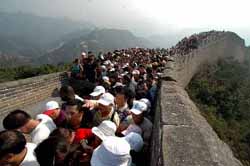
A dedicated team is to patrol Great Wall to check against damage
of the mammoth structure.
The unit will focus on the 630-kilometer-long section in
Beijing. Team members, who will be paid by local governments, will
be mainly rural residents who live near the Wall, said Yu Ping,
deputy director of the Beijing Municipal Administration of Cultural
Heritage.
It is the first time that the Wall in Beijing has had a special
team to guard its ancient facade, of which only less than 20
percent has been well preserved, Yu said.
It follows growing concern over the impact of tourism on the
structure.
Currently, about 10 kilometers of the Beijing section of the
Great Wall, such as Badaling and Mutianyu, is open to visitors.
Saturated tourism is often blamed for damage to the oriental
epitome of ancient Chinese civilization. Almost every brick at
Badaling has been carved with people's names and graffiti.
Other sections, which are called "wild wall" and not open to the
public, also suffer from man-made damage. Neighborhood villagers
often put up iron ladders illegally to lure hikers to step up to
it.
Apart from the patrol team, Yu said her administration will
start to draw up a detailed layout of a buffer zone this year for
the Wall, which will take up to three years to be finished. At
present, only a general standard ranging from 500 meters to 2
kilometers away from the Wall is designated as a buffer zone to
protect it.
The administration also plans to draw up an overall report this
year, including the history, current condition and future
protection plans of the Wall.
"The report is expected to come out in 2008 or 2009," Yu said.
"We will open the report to the public when it is finished."
Besides the Great Wall, dozens of other heritage sites in the
capital will be repaired this year.
Renovation efforts will first kick off in March to repair the
Temple of Dragon King (or God of Rain), the only heritage site
located at the heart of the future Olympic Village, according to
Mei Ninghua, director of the heritage bureau.
There are two main halls, several affiliated rooms and some
carving stones left at the site of the temple, which was first
built in Qing Dynasty (1644-1911), archaeologists said.
The project will cost about 5 million yuan (US$616,500), said
Mei, adding that it is part of an ambitious heritage protection
plan that aims at rehabilitating the city's ancient flavor for the
2008 Olympic Games.
The municipal government pledged to invest 120 million yuan
(US$15 million) in heritage renovation every year between 2003 and
2007.
"As the Games is impending, the year of 2006 will be crucial for
the protection of cultural relics in the capital," said Mei.
Wang Yuwei, an official with the bureau in charge of relics
protection, said more than 200 famous heritage sites around the
city, including ancient temples, imperial gardens, residences of
nobility and imperial tombs, have already been repaired or are to
be repaired before 2008.
A survey carried out by Mei's bureau showed more than 60 percent
of the city's heritage sites are occupied by residents and
institutions that do not pay enough attention to maintenance and
protection of the ancient buildings.
"The lack of efficient protection at some sites has led to worse
destruction than the burning of the Old Summer Palace, which was
ignited by English and French armies in 1860," Mei claimed.
Apart from the preservation of famous heritage sites, the city
will make more efforts to protect its old city regions as a whole,
including the traditional alleys and courtyards, cultural heritage
officials said.
Reviewing last year's work, Mei said one of the most prominent
events was the "explosive" development of the relics auction
market.
More than 70,000 ancient works of art went under the hammer last
year, raising nearly 5.2 billion yuan (US$650 million) in Beijing,
a historical year-on-year increase of 233 percent, said Fu Gongyue,
another official from Mei's bureau.
However, only 61.3 percent of the auctioned relics were under
the supervision of heritage authorities, he said.
Among them, 25 national treasures were pulled from auction,
raising awareness of the need to better protect cultural relics, Fu
said.
(China Daily February 16, 2006)

